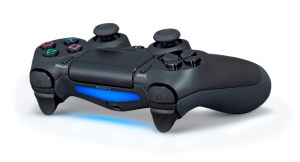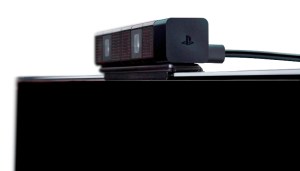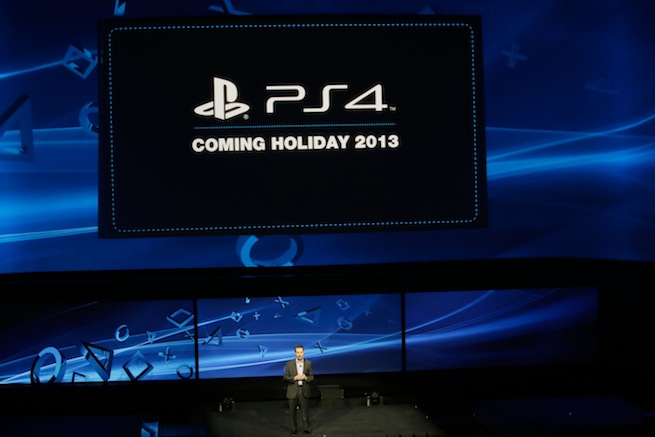Read all of our PlayStation 4 coverage here.
As the curtain closed on Sony’s revelation of the PlayStation 4, I was pretty excited. After all, Sony hasn’t revealed this much about the future of games since 2005 and 2006. But some of that reality distortion field is wearing off, and I’ve decided to take a step back and rate the overall goods that Sony delivered against expectations.
 I was annoyed that Sony didn’t say more. The Japanese company revealed a fall launch, but not a launch date. It didn’t show the box, talk about the price, or say if it had functioning hardware. Given the history of console-first revelations, that’s typical. After all, it doesn’t want to give too many answers to its rivals Microsoft and Nintendo, which will maneuver based on what they learn about Sony’s strategy. And it doesn’t want to overpromise and underdeliver.
I was annoyed that Sony didn’t say more. The Japanese company revealed a fall launch, but not a launch date. It didn’t show the box, talk about the price, or say if it had functioning hardware. Given the history of console-first revelations, that’s typical. After all, it doesn’t want to give too many answers to its rivals Microsoft and Nintendo, which will maneuver based on what they learn about Sony’s strategy. And it doesn’t want to overpromise and underdeliver.
Still, I come away unsure about whether Sony “gets it” and really understands how to make itself relevant in game world that is full of business and technology disruptions. Sony answered this in part, but not in full.
But some questions are being answered as I write. Sony didn’t say, for instance, if the PS4 would play used games — considered a sacred right of fair use by many gamers. But Sony’s game studio chief Shuhei Yoshida told Eurogamer that players would indeed be able to. By the Electronic Entertainment Expo (E3), Sony should address all of our lingering doubts.
 I was intrigued to notice that Sony is continuing a tradition of learning from Westerners. It didn’t learn all that much from former chief executive officer Howard Stringer, the first Brit to run Sony. But Andrew House, the head of the company, came out on stage instead of current CEO Kaz Hirai.
I was intrigued to notice that Sony is continuing a tradition of learning from Westerners. It didn’t learn all that much from former chief executive officer Howard Stringer, the first Brit to run Sony. But Andrew House, the head of the company, came out on stage instead of current CEO Kaz Hirai.
The lead system architect was Mark Cerny, who has tremendous respect among game developers (and is fluent in Japanese). I hear from a good source that Cerny was able to get good feedback from the West and translate that to the Japanese system engineers, and most of the user interface for the new machine was created in the West as well.
Dave Perry, the CEO of Gaikai (the cloud-gaming startup which Sony bought for $380 million), talked about Sony’s broader network strategy.
This fresh crew of leaders shows that Sony is listening to the markets that matter, as the U.S. and Europe are critical to the success of any console. In the past, Sony’s thinking seemed to be too insular and too focused on Japanese styles of doing business. Fair or not, I associate that with being unable to learn from startups — not open enough — and failing to listen closely to the desires of game developers.
Perry’s technology has brought some much-needed flexibility to Sony’s console business. Cloud gaming is potentially disruptive as it allows a publisher to run a game in an Internet-connected cloud and stream it from the data center to any client. Sony can use it for backward compatibility, allowing you to play older PlayStation, PS2, and PS3 games on the PS4.
It remains to be seen how much full game streaming will be enabled by the Gaikai technology. You can certainly use the game streaming to play demos, and it’s good that Sony fully embraced game downloading by enabling you to do it in the background, while you’re doing other things like playing games, said analyst Atul Bagga.
And the streaming technology from Gaikai also allows you to play PS4 games on a handheld PlayStation Vita and perhaps other devices as well. I really like this aspect of the technology, which House said puts the gamer at the center of the ecosystem, rather than the living room console. It embraces the reality of mobile devices being used in concert with a console.
The cloud gaming technology can get rid of the need to put backward-compatibility hardware in the console, lowering its costs. Ultimately, no one cares about backward compatibility except at the very beginning of a console sales cycle. So enabling it with as little cost as possible is an absolutely necessary ingredient of a modern game console that Microsoft has to match.

The cloud solution also allows Sony to break with the mistakes of its past. The Cell processor from IBM, Toshiba, and Sony was never popular with developers, who hated its complexity. Intel’s own chips were too expensive, but the accelerated processing units (APUs) from Advanced Micro Devices fit the bill. The eight x86 64-bit cores are both powerful and inexpensive. They can be put on the same chip as a graphics processing unit, reducing the cost and complexity of the console. And they bring the economic efficiency of the PC and its volume cost reductions to Sony while offloading considerable engineering tasks.
PC gamemakers will embrace this solution as they already know how to program PC games using the same technology. This is a big step toward simplification of the game development process, and that could help lower costs, rather than constantly increase them. The move toward the PC will get more developers on Sony’s side. After coming in third place with the PlayStation 3, Sony needs to convince developers that they will profit by sticking with Sony. And it needs to reveal games that are better on the console than they will be on the PC.

Sony showed off a bunch of cool-looking games from a number of third-party developers. But many of them are not that exciting when you consider whether they will be exclusives. Ubisoft’s Watch Dogs, Bungie’s Destiny, Quantic Dream’s Beyond: Two Souls, Capcom’s Deep Down, and Square Enix’s Final Fantasy game will likely also appear on the next Microsoft console. Those games certainly show off the kind of outstanding entertainment that will define the next generation. Quantic Dream’s rendering of a human face looked extremely realistic.
But Sony didn’t show off the “only on PlayStation 4” titles. Bungie’s game, for instance, will also debut on the PlayStation 3 at the same time as it appears on the PS4.
But I can’t fault Sony too much here. It did show off some cool Sony-owned content. Sony’s Killzone: Shadow Fall looked stellar, but it is one more installment in an aging franchise. The Killzone demo certainly looked like it was running live, in real-time, on prototype hardware. That’s a good sign, and it is welcome, considering that it’s easy to play tricks by faking game play by using animated movies in place of real-time live gaming. I may have been fooled, but it certainly looked nice. I hear that the prototype hardware is plentiful and developers are using the machines to create their games.
The Drive Club from Evolution Studios is a unique take on social racing. Knack could have a place in the comic-combat genre. And Media Molecule seems to have a weird gesture-based sculpture game in the works. I was impressed that some of these developers said they had been working for years on PS 4 titles, or at least were working on their concepts for a long time.
But many fans were flabbergasted that there was still no mention of Sony’s The Last Guardian, a title that has been missing in action for years. Square Enix made a major fumble, too, when it showed an old trailer and still didn’t describe the game that the video revealed. The company obnoxiously told the crowd to wait until E3.
I wondered why Electronic Arts wasn’t there in a big way as the company is still a major player in the industry. But EA probably didn’t have a brand new intellectual property that was ready to unveil yet. Still, the absence of the big player will set some conspiracy theories in motion. I have no doubt that Sony has enough backers, but it should show more of them.
 I was also disturbed that Sony said little about its own response to two major disruptions in the games business. Sony didn’t say what operating system the PS4 runs, but I hear it isn’t Android. It’s another custom-made Sony operating system, designed to run games fast.
I was also disturbed that Sony said little about its own response to two major disruptions in the games business. Sony didn’t say what operating system the PS4 runs, but I hear it isn’t Android. It’s another custom-made Sony operating system, designed to run games fast.
Is it a mistake? Sony might have embraced the open nature of operating systems like Android and the innovation that comes from mobile devices such as smartphones and tablets. An open OS is upgradeable and flexible to change with the times.
Embracing Android would also invite large numbers of indie game developers to make games for the PS 4. Sony did not do a very good job of communicating this goal of getting more indies in its press conference and in a follow-up interview with Gamasutra. It is being too vague. But from what I hear, the console isn’t going to be as magically easy for indies to self-publish games on — at least not as easy as it is on Android. Until we know where Sony stands on this, we won’t know what it really means by being “more open.”
Sony did embrace sharing on platforms such as Twitter and Facebook. It embraced video spectating via services such as Twitch. And it also will host a variety of non-game video services, from Netflix to Vudu. That will help it fulfill the PS4’s role as an entertainment device, beyond a game console. But I saw no evidence that Sony will catch up with Microsoft’s superior Xbox Live service.
Sony also didn’t speak much about free-to-play games. Indeed, other players like Nvidia, PlayJam (GameStick), Ouya, and others are trying to bring those disruptive forces to the TV. If Sony doesn’t do it, then these other players have a chance, and so does Microsoft.
I do think that Sony showed off enough to do a great deal of PR damage to Nintendo, whose Wii U game console isn’t selling as well as it hoped. If Sony comes out with the right games, the right price, and the right launch date, the PlayStation 4 could be a huge threat to Nintendo’s console.
To sum it up, Sony’s revelation raised more questions than it answered. That’s par for the course in the games business, as most major revelations don’t take place until E3 in June. But I wish there were more “wow moments” than questions or disappointments. In that respect, Sony left some major openings for Microsoft to exploit.
VentureBeat's mission is to be a digital town square for technical decision-makers to gain knowledge about transformative enterprise technology and transact. Learn More

